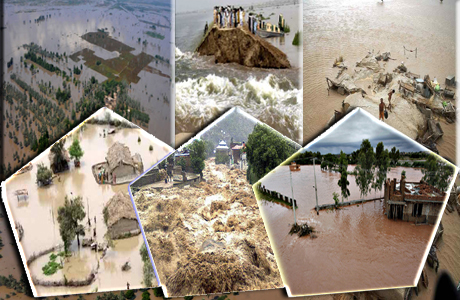The climate challenge
By Haroon Janjua
 The
climate change phenomenon, which the world has been
witnessing lately, is exhibiting unforeseen and asymmetrical
patterns.
The
climate change phenomenon, which the world has been
witnessing lately, is exhibiting unforeseen and asymmetrical
patterns.
On the one hand, plains in
Punjab are seriously impacted under a severe patch of
flooding, while the muzzle of the Thar Desert is bringing
about a drought-like situation, given this year’s
impoverished monsoon period.
As is evident from a
season of longer spells of heavy rains, withering floods and
droughts in parallel, Pakistan is experiencing the worst
effects of climate change. These wet and dry conditions
present serious threats to agriculture, industry, water
resources – in fact, the country’s overall economic
framework.
As the climate has become
warmer, these extremes in weather patterns have become more
frequent and dangerous due to increase in extreme heat,
scarce precipitation and drought.
Heat waves become longer and
hotter with continuous fluctuation in their intensity.
Flooding due to heavy
torrential rains has also become continual and recurrent. In
a wide swing between such extreme conditions, drought and
famine have also become highly intensive.
Weather is developing in a different manner, shifting what
used to be moderate into what is now clearly visible as
extreme variations. These intense events that would
otherwise be rare have now accelerated to a frequent pace.
For example, until some
decades ago, the annual temperature ranges had normal
variances. However in the past few years, with 2010 being
the watershed year, the Annual Temperature Range has been
growing, mostly owing to an increase in the maximum
temperature that is recorded in the summer months.
In 2010, across Sindh and in
parts of Blochistan, the highest temperature was 50 to 52
degrees continuously for 10 days.
It is worth mentioning that parts of Punjab during this year
and in this period also saw a heat wave with temperatures
lasting for days around 48 to 50 degrees.
This heat wave was followed
by a massive flood caused by unexpected torrential rains,
that brought with them loss of almost hundreds of lives,
thousands of livestock, submerging of tens of millions of
fertile agricultural land, inundation of the most critical
of power plants, besides causing a major law and order
problem, with the army diverting its attention to rescue and
relief.
As happened in 2010, highly frequent and increasingly severe
changing weather patterns weaken the critical components of
the economy and impact livelihood of the population.
Climate change is therefore
impacting a huge portion of population across the planet
earth in one way or the other.
The Asian Development Bank in
its recent report, ‘Assessing the Costs of Climate Change
and Adaptation in South Asia’ found that “Climate change
will affect South Asia more than most other regions.
South Asia’s weather is
likely to become hotter than the global average, while
monsoon rains and heavy storms will increase in most parts
of the region.
As well, the mountainous
countries face increased flooding and landslides, while the
coastal countries of the region are likely to be partly
inundated by sea-level rise”.
The recent floods in Pakistan have inflicted heavy losses of
human lives, property and infrastructure and water is
continuously flowing towards the shallow regions of southern
Punjab and Sindh.
Till now the alluvions in
Chenab and Jhelum, following the heavy torrential rains, had
displaced, stranded and affected around 2.1 million people,
washing away or gravely damaging over 32,000 houses in
several districts of central and southern Punjab.
Climate change is not limited to devastating floods only; it
is equally hurting the lives of those living in deserts and
in other arid regions. For Thar's desert inhabitants, their
domesticated animals are a vital piece of their existence
and can make the difference between life and death to them.
Tharis relocate to different
parts of Sindh to discover occasional work; but reports
suggest that a few families are permanently leaving their
local zones.
Dry spell like conditions had
manifested recently, with various children reportedly dying
from lack of healthy sustenance or inadequate medical
facilities.
In August Marubhat committed suicide in the grave misery of
being unable to give food to her children. In the recent
past, 24 suicide cases were registered in 2011 and 35 in
2012.
These suicides are to a great
extent credited to an increase in instances of aggressive
behavior at home and neediness in the region.
The current year’s drought is
expected to be the most terrible. A dry spell is an
immediate consequence of late rainstorm or in Thar’s case an
absence of it.
The Pakistani economy is highly dependent on agriculture and
if certain measures are not taken the country may confront
genuine threats.
To save agriculture, which is
the nation's mainstay, farmers are presently being prompted
by experts to reconsider their harvest timetable and begin
sowing cotton two months prior so that the product is
harvested before the monsoon hits.
Rice cultivators; again,
ought to strive for deferred planting.
There is a need to bring in new mixed varieties of wheat,
rice and sugarcane which can grow faster and survive storms
and delayed drought.
There is an agreement that
new dams can control and deal with the future surge of the
currents of the rivers. Or else the nation will undoubtedly
see a greater amount of such deluges and additional
problems.
For the long haul strategies need to combined with the goal
that individuals and domesticated animals are protected from
the crushing impacts of nature calamities.
September, 2014
Source:
The News